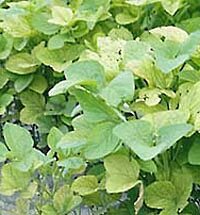
- Agronomics
-
Diseases
- Asian Rust
- Anthracnose
- Bacterial Blight
- Bacterial Pustule
- Bean Pod Mottle Virus
- Brown Stem Rot
- Cercospora Leaf Blight
- Charcoal Rot
- Downy Mildew
- Frogeye Leaf Spot
- Green Stem Syndrome
- Iron Deficiency Chlorosis
- Phytophthora Root & Stem Rot
- Powdery Mildew
- Rhizoctonia
- Seedling Diseases
- Septoria (Brown Spot)
- SCN (Soybean Cyst Nematode)
- Soybean Mosaic Virus
- Stem Canker
- Sudden Death Syndrome
- Viruses
- White Mold
- Pests
- Biological Control
- Diagnostic Tools
- About Us
- Library
| Agronomics: Soils |


Your soybean checkoff.
Delivering Results.
Iron Deficiency
 |
| Iron deficiency symptoms in soybean. Photo © Edwin J. Penas and Richard A. Wiese, University of Nebraska |
Most soils contain abundant levels of iron. However, at high soil pH (greater than pH 7.5), iron is not soluble and cannot be absorbed by plant roots. Iron in this form will not be available to the plant unless soil conditions change.
Iron is necessary for the formation of chlorophyll, which is the green pigment in plants. When the amount of iron available to plants is inadequate for normal growth, new leaves become pale green, yellow or white, particularly between the veins. This loss of green color is called iron deficiency chlorosis, or IDC.
The effect of chlorosis on the plant is reduced growth and yield. Iron is necessary for nodule formation and function, and when deficient can result in reduced nitrogen fixation.
Chlorosis of soybeans does not occur on all high-pH soils. Even within a field with high pH soil, areas of chlorotic and nonchlorotic soybeans can be found. Researchers have noted that conditions in the subsoil may vary. Subsoil in areas with chlorotic soybeans are often poorly drained, higher in pH, higher in soluble salts and in excess lime (carbonates) compared to areas where soybeans do not have IDC.
Management options for iron-deficiency chlorosis
- Variety selection and rotation. The most successful management of iron deficiency chlorosis is the selection of soybean varieties with tolerance to the soil and environmental conditions that lead to iron chlorosis. There have been major improvements in soybean varieties in this respect, and most public and private soybean varieties have been rated for IDC tolerance. However, variety performance can be quite variable. This may be a result of variety evaluations in too few years or locations.
- Rotation with small grains such as oat or wheat, which are better able to remove bound iron, may improve availability to subsequent crops.
- Soil management, including manure applications to improve soil chemistry. Application of iron is also an option but it may not be applicable to most situations because the soil binds additional iron, and high concentrations of iron are toxic to soybean plants.
- If overwatering or poor drainage are possible causes, they should be corrected.
Resources
Is it potassium or iron deficiency?
Iowa State University
Iron chlorosis shows up
Iowa State University
Iron Deficiency of Soybean in the Upper Midwest and Associated Soil Properties
N. C. Hansen, M. A. Schmitt, J. E. Anderson and J. S. Strock
Agronomy Journal 95: (2003).
Genotype x Environment Interactions within Iron Deficiency Chlorosis-Tolerant Soybean Genotypes
Seth L. Naeve and George W. Rehm
Agronomy Journal 98:808-814 (2006)